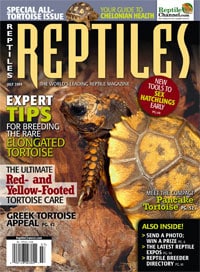Because I’m the editor of the world’s most successful reptile magazine (hey, it’s my blog, and I can toot my mag’s horn onc
Because I’m the editor of the world’s most successful reptile magazine (hey, it’s my blog, and I can toot my mag’s horn once in a while if I want to) it seems appropriate to occasionally give you a look into what goes on around here, and how the magazine is put together. I’ll give you a sort of behind-the-scenes peek, so to speak.
Today, I will reveal the complicated, often mysterious (not really), process with which we find REPTILES magazine authors. Publishing professionals, especially, should pay close attention. You may learn something.
Before we begin looking for authors, the editors hash out an editorial calendar. This is a blueprint of sorts for all the articles that will be appearing in a year’s worth of magazines, from the January issue to the December issue. Usually my managing editor, Stephanie Starr, will create the first draft, after discussing with Sandy Quinn, the magazine’s sales manager, trends she may have been noticing out in the field (if you read Tuesday’s blog, you’ll know Sandy’s out there a lot more than us editors, who are shackled to our desks). Steph will also use an ongoing list of possible article topics that we keep. Topics end up on it when we realize something like, “Hey, we haven’t done a blue-tongued skink article for awhile. Add that to the ‘to-do’ list,” and onto the list it goes.
Steph puts the first draft together and then I look it over, tear it up and make her redo it completely, right down to the font that was used for the type.
I’m kidding, though it might be tempting to flaunt my power and do that someday. Usually, though, I look over the initial draft of the editorial calendar and either approve it or suggest some additional changes.
When planning the editorial calendar we also try to include enough stuff to appeal to as broad a range of herp hobbyists as possible. With the exception of an occasional special issue devoted to a specific group of animals, such as lizards or turtles and tortoises, we shoot for a mix of articles in each issue that relate to as many different aspects of the hobby as we can reasonably muster, whether we’re talking about animal husbandry, field herping, medical issues and whatnot.
Once the calendar is finalized – though it remains pliable and sometimes changes slightly over the year — we embark upon our author hunt. Have you ever seen the movie Planet of the Apes, in which the apes are chasing down the humans with nets and on horseback, as the humans tear through a field of tall grass? It’s just like that.
Har! I’m kidding again, of course. We use stun guns, not nets.
But now, back to reality…
After nearly 16 years in the reptile article business, we’ve got a pretty hefty Rolodex, both physical and mental, with a lot of reptile experts’ names in it. We know people who are breeding which types of animals, and we know a lot of the “names” in the business. There are the well-known titans in the industry such as Ron Tremper, Bob Clark, the Barkers, Kevin McCurley and others who I hope don’t get mad that I didn’t include them by name in this sentence. The point is there are more professional reptile breeders than ever before, and we search among them to find the ones who like to write about their experiences.
I always mandate that if someone is going to write about a specific type of reptile or amphibian, that they have experience with that animal. Preferably, they have not just kept it, but also have bred it successfully. The fact of the matter is we editors are not experts on every reptile (frankly, I don’t think I’d consider myself an expert on any animal), and we rely on our authors to know what they’re writing about.
The Internet, of course, is a huge help to us when looking for authors. We’ll search breeders’ websites to see what animals they’re working with. We’ll also meet people at reptile expos. Potential authors will contact us, too, to introduce themselves and pitch an article idea. Or they may be referred to us by other people, including authors who have already worked with us. Check out our writer's guidelines here.
When new authors approach me with article suggestions I’ll ask them about their experience with the animals they want to write about. If they seem to know their stuff, I’ll invite them to submit an article – preferably with good photos – on “spec.” This means it’s being sent on speculation, in that I am telling them I’ll look it over but am not making any promises that I will accept it or agree to publish it. After all, why would anyone agree to publish something sight unseen from someone with whom they’ve never worked? Not me!
And that’s basically how it goes. An article arrives, the editors review it, and if it’s not rejected outright a contract is sent to the author to sign. Later, during the editing process, the article may get batted back and forth between the editors and authors until it’s finally ready to appear in print. Then it’s only a matter of it next being seen by thousands of REPTILES magazine subscribers, as well as many more thousands of ReptileChannel visitors, if the article ends up on this website (not all articles do).
So there you have it, a glimpse into the inner workings of REPTILES magazine. I hope you found it interesting. Maybe it would be more interesting if nets and horses figured into the process, but I hope you found the information enlightening all the same.


